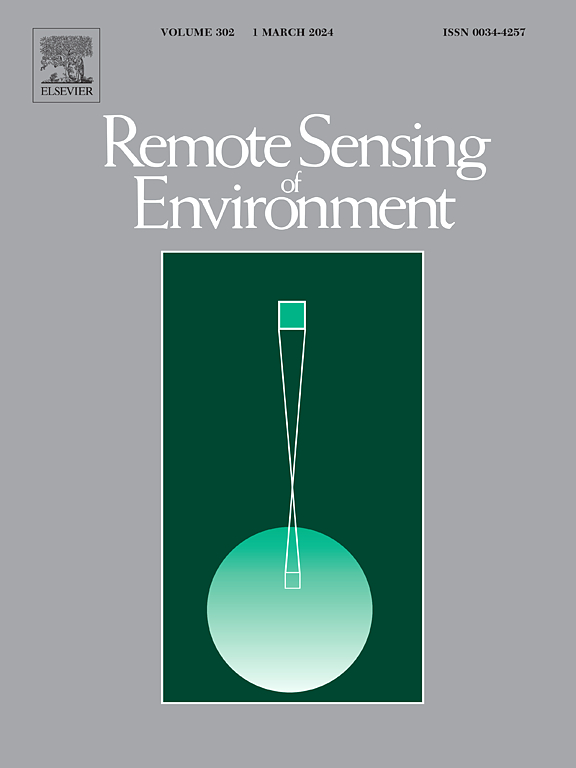One-step retrieval of water-quality parameters from satellite top-of-atmosphere measurements
IF 11.1
1区 地球科学
Q1 ENVIRONMENTAL SCIENCES
引用次数: 0
Abstract
Traditionally, deriving water-quality parameters from satellite ocean color measurements involves multiple complex steps, including in-orbit radiometric calibration, atmospheric correction, and water property retrieval, all of which require substantial resources and effort. Given the abundance of water-quality related products provided by established ocean color satellite missions, we propose a scheme (DN2WP) to estimate water-quality parameters directly from the digital number (DN) data obtained at satellite altitude. Using Secchi Disk Depth (ZSD) as an example and the ZSD data from Sentinel-3 as a reference, HiSea-II DN data were converted to ZSD directly by DN2WP. In the training phase, the coefficient of determination (R2) for ZSD reached 0.95, with a mean absolute percentage difference (MAPD) of ∼10 %. When applied to new datasets, the R2 for ZSD exceeded 0.8, and the MAPD remained within 20 %. The DN2WP scheme was further tested using the multispectral sensors of the CZI on board the HY-1C satellite and MII on the SDGSAT-1 satellite, respectively, and a high level of performance was maintained by achieving an R2 of 0.83 (0.84) with MAPD as 19.8 % (15.8 %) for CZI (SDGSAT-1) on independent data. These results are significantly better than the consistency measure of ZSD between such satellites and Sentinel-3A/3B obtained individually through the traditional multi-step approach. It indicates that DN2WP is an efficient approach to get water-quality parameters from top-of-atmosphere DN data measured by a satellite sensor, which also results in much better consistency across different satellite missions.
从卫星大气顶测量数据中一步反演水质参数
传统上,从卫星海洋颜色测量中获得水质参数涉及多个复杂步骤,包括在轨辐射校准、大气校正和水属性检索,所有这些都需要大量的资源和努力。鉴于已建立的海洋颜色卫星任务提供了丰富的水质相关产品,我们提出了一种方案(DN2WP),直接从卫星高度获得的数字数字(DN)数据估计水质参数。以Secchi Disk Depth (ZSD)数据为例,以Sentinel-3的ZSD数据为参考,利用DN2WP将HiSea-II DN数据直接转换为ZSD。在训练阶段,ZSD的决定系数(R2)达到0.95,平均绝对百分比差(MAPD)为~ 10%。当应用于新数据集时,ZSD的R2超过0.8,MAPD保持在20%以内。采用HY-1C星上的CZI多光谱传感器和SDGSAT-1星上的MII多光谱传感器对DN2WP方案进行了进一步测试,CZI (SDGSAT-1)在独立数据上的R2为0.83 (0.84),MAPD为19.8%(15.8%),保持了较高的性能水平。这些结果明显优于传统多步骤方法单独获得的Sentinel-3A/3B卫星ZSD的一致性测量。这表明DN2WP是一种从卫星传感器测量的大气顶DN数据中获取水质参数的有效方法,并且在不同卫星任务之间具有更好的一致性。
本文章由计算机程序翻译,如有差异,请以英文原文为准。
求助全文
约1分钟内获得全文
求助全文
来源期刊

Remote Sensing of Environment
环境科学-成像科学与照相技术
CiteScore
25.10
自引率
8.90%
发文量
455
审稿时长
53 days
期刊介绍:
Remote Sensing of Environment (RSE) serves the Earth observation community by disseminating results on the theory, science, applications, and technology that contribute to advancing the field of remote sensing. With a thoroughly interdisciplinary approach, RSE encompasses terrestrial, oceanic, and atmospheric sensing.
The journal emphasizes biophysical and quantitative approaches to remote sensing at local to global scales, covering a diverse range of applications and techniques.
RSE serves as a vital platform for the exchange of knowledge and advancements in the dynamic field of remote sensing.
 求助内容:
求助内容: 应助结果提醒方式:
应助结果提醒方式:


